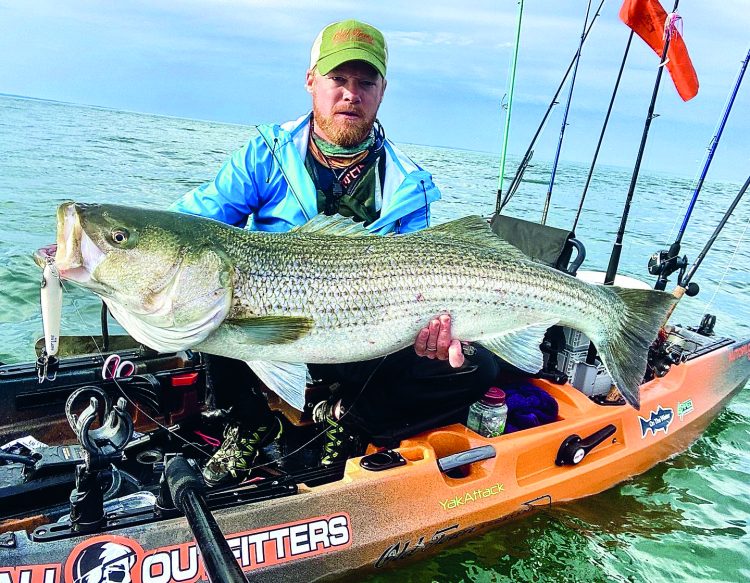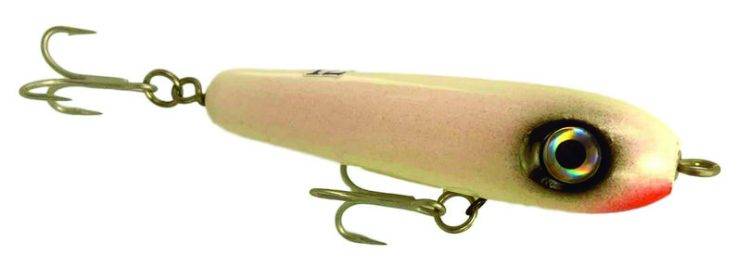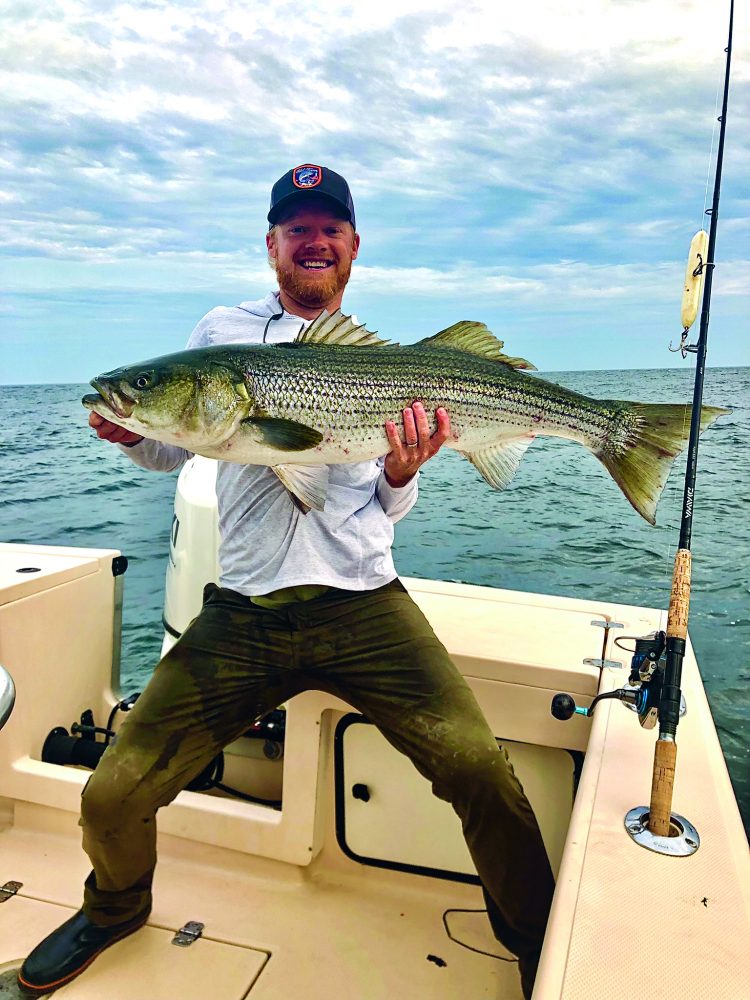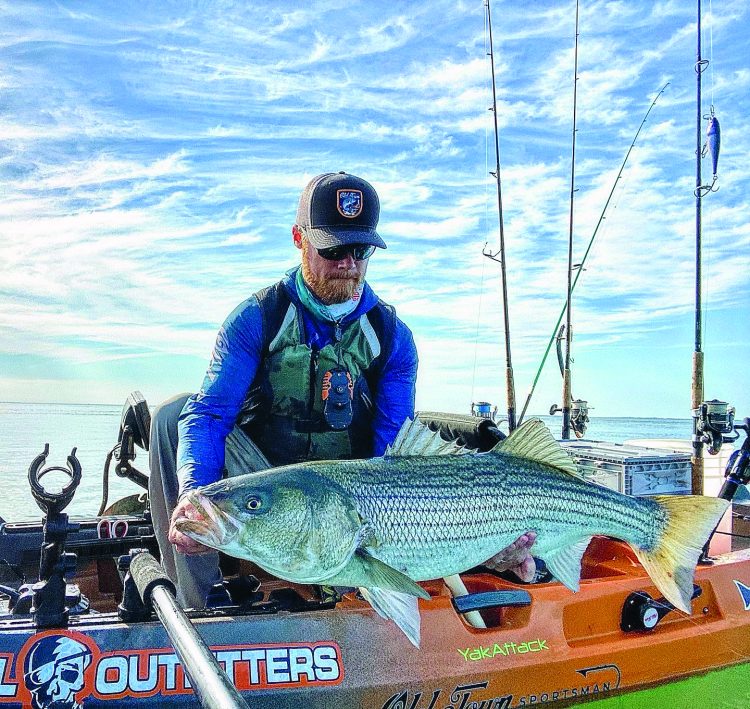Cow Tipping: Catch Giant Striped Bass by Kayak
Adjust your striper-fishing strategies to target big fish instead of schoolies.
The hero shot … a smiling angler, proudly holding up a giant striped bass with its gills flared and pearlescent belly bulging as seven horizontal stripes trace its massive bulk from maw to tail. Every year, photos of gigantic striped bass spread throughout social media, online fishing reports, and cellphone group chats. Love ‘em or hate ‘em, they never fail to elicit an acute pang of desire to get on the water.
Photos of trophy striped bass are gasoline poured on the fire that burns in anglers’ hearts. Because of them we get up a bit earlier, cough up a bit more cash for an upgraded setup, or spend a few more lunchbreaks pouring over maps. For anglers who have landed plenty of schoolies on their striped-bass journey but have struggled to land a true “cow,” it all leads to one question: How do I catch one of those giants?
As an avid kayak angler and summertime tackle-shop employee, I’ve been asked some form of this question dozens of times. While it’s a straightforward question, the answer is anything but. It seems like some fishermen can snap their fingers and a 48-inch striper latches onto their hooks, while others put in long hours, chuck thousands of casts, and burn a financially distressing amount of gasoline without having any success. Naturally, charter captains are going to have their fingers on the pulse of the current bite, but the average weekend warrior faces a much taller task when getting a bead on where, when, and how to battle their own giant striper.
I can already hear the rumblings from salty veteran anglers: “You gotta put in the time; that’s how you get them!” It’s true, there’s no substitute for time on the water and the wisdom that trickles in, cast by cast, during years of pursuit. However, consistent fishing isn’t an option for many. And no matter how much time you spend on the water, there are ways to increase the chances of coming across and fooling a memorable striper. A solid helping of these tips, combined with the requisite time on the water, can be a recipe for success in the pursuit of cow striped bass.
Gear Up
I’ve been that guy, struggling to toss a 3-ounce plug with a 7-foot medium-power budget spinning rod. It’s not a great look, and while it’s possible to fling a plug of that size using a light rod, to call it a “cast” might be pushing it, not to mention imparting effective action to it or landing the fish if one gets fooled. In that vein, the first task when pursuing 40-inch-class stripers should be upgrading to gear fit for the job at hand.

Using a combo sized for launching larger lures and fighting trophy-sized fish has benefits that go well beyond a “bigger is better” mindset. It allows you to cover much more ground with longer casts and to properly fish natural baits and work lures. Depending on their mood, trophy stripers can take a long time to look at your presentation, perhaps giving it an irked swipe or two before fully committing. A 10-yard cast might work well when flipping brush for largemouth, but to increase your chances of tangling with a giant striper, I recommend longer casts and covering water. Consider rods in the 7’6” medium-heavy to 8’ heavy range, and reels from sizes 5000 to 7000, and don’t forego appropriately strong line.
I still recall my first few trips in Long Island Sound after purchasing a heavier combo. It felt like an entirely new style of fishing. I realized that if a plug was burdensome for me to cast and retrieve, there was a slim chance that its action was natural and enticing. Looking back, I cringe thinking about how many memories I didn’t make because I was using undersized gear. Upgrading combos isn’t cheap, but it does eventually pay off, especially if you want to use your combo with a giant-slaying plug.
Big Lures and Live Bait
My first love in the custom plug world was a 4.5-inch long, pearl-and-chartreuse “Dirty Mullet” topwater spook designed by Bad Monkey Lures in North Carolina. It has caught me many fish of all sizes. However, as I put in hours on the water and observed the more talented anglers around me, it became clear that catching mammoth stripers consistently meant two things: using big lures and live bait.
After ensuring I had the gear to do so, I started throwing plugs such as the Doc, the Mully by 24/7 lures, a Slim Glide by Solstice Lures, and other large presentations. Additionally, I learned the nuances of using live eels, both weightless and on a 3-way rig for deeper water. It didn’t take long before I dedicated an entire tackle box to live-eel imitations, like the 13.5-inch GT Eel by Gravity Tackle. The results spoke…loudly. While smaller stripers still hit these lures on occasion, cow bass were far more willing to obliterate a 9-inch spook than a 4.5-inch one. And yes, Albie Snax soft plastics and small poppers are fun schoolie-busters, but there is no denying that bigger baits are the ticket for bigger bass. Using these baits may cut down on the quantity of stripers landed, but if the goal is to land your first 40-, 45-, or even 50-inch bass, they will increase your chances.

Structural Knowledge and the Air-Conditioner Theory
Years ago, while helping a buddy pre-fish for a tournament on the lower Susquehanna River in Maryland, I lost what looked to be a 7-plus-pound largemouth right at the side of the kayak. “The big ones get big for a reason!” was his only consolation for my broken heart but, man, was he right. Fish of that caliber are smart, battle-tested survivors, and trophy-class stripers embody those traits better than any I’ve chased.
To consistently catch world-class stripers, you’ve got to be in the right place at the right time. When breaking down my local waters for big striped bass, I think of trout streams. Odd, right? Hear me out. The interaction of current and structure on a rocky point in the Atlantic is essentially a scaled-up version of the way rocks and boulders manipulate water in smaller trout streams and backwoods brooks. Eddies, riffles, pools, and tail-outs aren’t terms I restrict to trout fishing. A 40-inch striper can sit in eddies in the Long Island Sound the same way a trout does in the Farmington River. While the stripers are near a boulder the size of a Mini Cooper, tuning into how tidal flow is altered by rocks, bridges, marshes, sandbars, and jetties can paint a clearer picture of where fish might be spending their time.

As you work a given area, pay special attention to what you can see on electronics and with your own eyes. Polarized sunglasses help a lot. Work your bait around, over, and next to notable features. Girthy striped bass are careful users of their finite energy stores. They might not be willing to exert the energy to chase plugs that are a dozen yards away but may willingly slurp something presented just feet from their faces.
These minutiae matter significantly more with trophy stripers than with smaller, haywire schoolies, whose level of recklessness equals that of the Seahawks trying to win the Super Bowl from the one-yard line with a slant pass.
In terms of time of day, most of the legendary and accomplished striper fishermen will tell you that night is right. Water temperatures cool, bait becomes active, and stripers have no problem using their lateral lines to chase and trap food in the shallows under the stars. However, night fishing comes with its own level of dedication and preparation, and it isn’t always possible for some anglers.
In lieu of fishing only at night, I target striper-rich waters using what I call “The Air-Conditioner Theory.” I picture the water as a house with separate rooms—some deep, some shallow, some current-driven, some calm. When waters cool after dark, even in midsummer, that “house” has A/C in every room. Those bass will move around comfortably and at will. This increased activity in shallow water is largely responsible for night anglers’ continued success. Conversely, during the day, especially in warmer months, shallow waters warm and become uncomfortable, like a house with a dozen rooms and only one air conditioner. As the water warms, those bass move, sometimes over a tide and sometimes rapidly, to cooler waters, which are often deeper. Anglers should adjust accordingly.
My typical summer day on the water is roughly 3 a.m. until noon. Early on, I stay shallow and work bait-rich structure. As the sun rises, I assume the bass are transitioning to more “air conditioned,” deeper water, and I adjust locations and presentations to match this thought. Large bass are less temperature-tolerant than schoolies and have no reason not to be comfortable, so they are particularly keen to spend their time where there is good oxygenation, usable structure, and plentiful bait. The time of day and specifics of depth that you target should reflect not only the structure you are fishing, but also the month, tide, and weather. Combined, a strong knowledge of the nuances of big-bass haunts can be crucial factors that turn the tables in your favor.
Don’t Accept Face Value
Landing my first trophy-caliber striped bass in the Long Island Sound was slightly more unique because it was the only fish I caught that entire day. It was a foggy, overcast July morning at 5:38 am, according to my phone’s photo data. A familiar rocky outcrop was the target. I was tossing a 24/7 Lures Mully, a 2-ounce spook that has since become my top-producing plug. I’d launched two hours earlier and had been completely skunked until that fish hit. Despite the cloudy day, I felt the early-bite window (often the most productive one during warm summer months) fading, so the lack of action was disappointing. Thankfully, that cow striper gulped down the Mully, taking me on an epic Nantucket sleigh ride and confirming that a lack of constant action does not mean a large bass isn’t willing to be active in the right moment.
This story highlights an important point when pursuing big stripers: Don’t accept at face value what the water is showing you, and don’t stop casting. Assuming you’ve done your homework, treat every cast like it could be “the one.” Trophy bass are different creatures and don’t always adhere to the same rules and patterns as their schoolie-size counterparts. As I’ve highlighted, there are various nuances that can make the difference between another schoolie added to your tally and the lifelong memory of a monster striped bass ripping line off the spool.

I think of trophy bass as lone wolves, and even though that’s not always true, it does help when piecing together the puzzle regarding their whereabouts and preferences. Chipping away at a school of smaller fish might eventually yield a memorable bass, but those fish are often not going to be in the fray with their feistier cousins. If you do find yourself witnessing some great blitzing schoolie and slot action, try dropping a spoon or live bunker down to the bottom and trailing the blitz. If there are bigger bass near the mayhem, they are often below and behind the schoolie turmoil, foregoing the chaos and positioning themselves for mop-up duty, happily slurping up the wounded bunker or anchovies that fall below the blitz. I can never help sending a smaller plug into a maelstrom of blitzing bass, but I eventually swap it for a bigger, bottom-focused bait to check for larger, more energy-cautious stripers below.
Quiet surface action doesn’t mean there are no giants below. Schoolies everywhere doesn’t indicate a lack of big fish. A slow start to a prime bite window is not indicative of an inevitable bad day. If you’ve been confidently landing schoolie and slot bass, but want to upgrade to a memorable giant, you’ve got to adapt and embrace the details. Try new water, pay close attention to what you see, learn on every single trip, and don’t forget that there are dozens of minor factors involved in tracking down these fish.
There is no “easy button.” Occasionally, luck plays a role, but the recipe for consistently landing big striped bass involves the right gear and lures, targeting the right waters and structure, and being on the water during prime bite windows. We revere these giant fish in part because of their size, but also because of their mystique. Follow these tips, keep up the hunt, and soon enough you’ll be the one in the hero shot!
Related Content
OTW Podcast #18: Kayak Stripers with Matt Stone
Leave a Reply